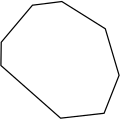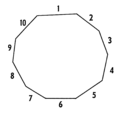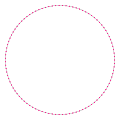Polygon
A polygon is a closed two-dimensional shape. It is a plane figure that is made up of a number of sides. These are also called edges or line segments. Each side is connected to another one by a corner, or vertex. Each pair of connected sides makes an angle.

These sides and angles can be different from one another, or they can all be the same. Polygons made of only sides of the same length (equilateral) and angles the same width (equiangular) are called regular polygons.
A square is a polygon because it has four sides. The smallest polygon in Euclidean geometry or "flat geometry" is the triangle, which has three sides and three corners. On a sphere, there can also be a digon and a henagon.
If the edge lines of the polygon do not cross each other, the polygon is called simple; otherwise it is complex.
In computer graphics, polygons (especially triangles) are often used to make graphics.
Gallery
- A complex pentagon
- A simple concave hexagon
- A non-regular heptagon
- A non-regular octagon
- A non-regular decagon
- A enneacontakaienneagon (a polygon with 99 sides)
List of polygons
| Name | Sides | Properties |
|---|---|---|
| monogon | 1 | Not generally recognised as a polygon,[1] although some disciplines such as graph theory sometimes use the term.[2] |
| digon | 2 | Not generally recognised as a polygon in the Euclidean plane, although it can exist as a spherical polygon.[3] |
| triangle (or trigon) | 3 | The simplest polygon which can exist in the Euclidean plane. Can tile the plane. |
| quadrilateral (or tetragon) | 4 | The simplest polygon which can cross itself; the simplest polygon which can be concave; the simplest polygon which can be non-cyclic. Can tile the plane. |
| pentagon | 5 | [4] The simplest polygon which can exist as a regular star. A star pentagon is known as a pentagram or pentacle. |
| hexagon | 6 | [4] Can tile the plane. |
| heptagon (or septagon) | 7 | [4] The simplest polygon such that the regular form is not constructible with compass and straightedge. However, it can be constructed using a Neusis construction. |
| octagon | 8 | [4] |
| enneagon (or nonagon) | 9 | [4] "Nonagon" mixes Latin [novem = 9] with Greek; "enneagon" is pure Greek. |
| decagon | 10 | [4] |
| hendecagon (or undecagon) | 11 | [4] The simplest polygon such that the regular form cannot be constructed with compass, straightedge, and angle trisector. |
| dodecagon (or duodecagon) | 12 | [4] |
| tridecagon (or trisdecagon) | 13 | [4] |
| tetradecagon | 14 | [4] |
| pentadecagon (or quindecagon) | 15 | [4] |
| hexadecagon (or hexakaidecagon) | 16 | [4] |
| heptadecagon (or septadecagon) | 17 | Constructible polygon |
| octadecagon | 18 | [4] |
| enneadecagon (or nonadecagon) | 19 | [4] |
| icosagon | 20 | [4] |
| icositetragon (or icosikaitetragon) | 24 | [4] |
| triacontagon | 30 | [4] |
| tetracontagon (or tessaracontagon) | 40 | [4][5] |
| pentacontagon (or pentecontagon) | 50 | [4][5] |
| hexacontagon (or hexecontagon) | 60 | [4][5] |
| heptacontagon (or hebdomecontagon) | 70 | [4][5] |
| octacontagon (or ogdoëcontagon) | 80 | [4][5] |
| enneacontagon (or enenecontagon) | 90 | [4][5] |
| hectogon (or hecatontagon) | 100 | [4] |
| 257-gon | 257 | Constructible polygon |
| chiliagon | 1,000 | Philosophers including René Descartes,[6] Immanuel Kant,[7] David Hume,[8] have used the chiliagon as an example in discussions. |
| myriagon | 10,000 | Used as an example in some philosophical discussions, for example in Descartes's Meditations on First Philosophy |
| 65537-gon | 65,537 | Constructible polygon |
| megagon[9][10][11] | 1,000,000 | As with René Descartes's example of the chiliagon, the million-sided polygon has been used as an illustration of a well-defined concept that cannot be visualised.[12][13][14][15][16][17][18] The megagon is also used as an illustration of the convergence of regular polygons to a circle.[19] |
| apeirogon | ∞ | A degenerate polygon of infinitely many sides. |





